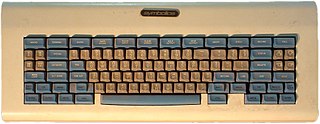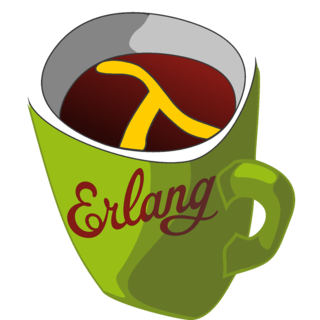
Common Lisp (CL) is a dialect of the Lisp programming language, published in American National Standards Institute (ANSI) standard document ANSI INCITS 226-1994 (S2018). The Common Lisp HyperSpec, a hyperlinked HTML version, has been derived from the ANSI Common Lisp standard.

Emacs Lisp is a Lisp dialect made for Emacs. It is used for implementing most of the editing functionality built into Emacs, the remainder being written in C, as is the Lisp interpreter.

Lisp is a family of programming languages with a long history and a distinctive, fully parenthesized prefix notation. Originally specified in the late 1950s, it is the second-oldest high-level programming language still in common use, after Fortran. Lisp has changed since its early days, and many dialects have existed over its history. Today, the best-known general-purpose Lisp dialects are Common Lisp, Scheme, Racket, and Clojure.

A signature block is a personalized block of text automatically appended at the bottom of an email message, Usenet article, or forum post.

In computer programming, an S-expression is an expression in a like-named notation for nested list (tree-structured) data. S-expressions were invented for and popularized by the programming language Lisp, which uses them for source code as well as data.
The ampersand, also known as the and sign, is the logogram &, representing the conjunction "and". It originated as a ligature of the letters of the word et.
In computer programming, cons is a fundamental function in most dialects of the Lisp programming language. consconstructs memory objects which hold two values or pointers to two values. These objects are referred to as (cons) cells, conses, non-atomic s-expressions ("NATSes"), or (cons) pairs. In Lisp jargon, the expression "to cons x onto y" means to construct a new object with (cons xy). The resulting pair has a left half, referred to as the car, and a right half, referred to as the cdr.
The tilde is a grapheme ⟨˜⟩ or ⟨~⟩ with a number of uses. The name of the character came into English from Spanish tilde, which in turn came from the Latin titulus, meaning 'title' or 'superscription'. Its primary use is as a diacritic (accent) in combination with a base letter. Its freestanding form is used in modern texts mainly to indicate approximation.
In computer programming, M-expressions were an early proposed syntax for the Lisp programming language, inspired by contemporary languages such as Fortran and ALGOL. The notation was never implemented into the language and, as such, it was never finalized.
Pretty-printing is the application of any of various stylistic formatting conventions to text files, such as source code, markup, and similar kinds of content. These formatting conventions may entail adhering to an indentation style, using different color and typeface to highlight syntactic elements of source code, or adjusting size, to make the content easier for people to read, and understand. Pretty-printers for source code are sometimes called code formatters or beautifiers.

REDUCE is a general-purpose computer algebra system originally geared towards applications in physics.

The space-cadet keyboard is a keyboard designed by John L. Kulp in 1978 and used on Lisp machines at Massachusetts Institute of Technology (MIT), which inspired several still-current jargon terms in the field of computer science and influenced the design of Emacs. It was inspired by the Knight keyboard, which was developed for the Knight TV system, used with MIT's Incompatible Timesharing System.

In software distribution and software development, a README file contains information about the other files in a directory or archive of computer software. A form of documentation, it is usually a simple plain text file called README, Read Me, READ.ME, README.txt, or README.md
In some programming languages, eval, short for evaluate, is a function which evaluates a string as though it were an expression in the language, and returns a result; in others, it executes multiple lines of code as though they had been included instead of the line including the eval. The input to eval is not necessarily a string; it may be structured representation of code, such as an abstract syntax tree, or of special type such as code. The analog for a statement is exec, which executes a string as if it were a statement; in some languages, such as Python, both are present, while in other languages only one of either eval or exec is.
An interrogative clause is a clause whose form is typically associated with question-like meanings. For instance, the English sentence "Is Hannah sick?" has interrogative syntax which distinguishes it from its declarative counterpart "Hannah is sick". Also, the additional question mark closing the statement assures that the reader is informed of the interrogative mood. Interrogative clauses may sometimes be embedded within a phrase, for example: "Paul knows who is sick", where the interrogative clause "who is sick" serves as complement of the embedding verb "know".
A read–eval–print loop (REPL), also termed an interactive toplevel or language shell, is a simple interactive computer programming environment that takes single user inputs, executes them, and returns the result to the user; a program written in a REPL environment is executed piecewise. The term usually refers to programming interfaces similar to the classic Lisp machine interactive environment. Common examples include command-line shells and similar environments for programming languages, and the technique is very characteristic of scripting languages.
Emacs, originally named EMACS, is a family of text editors that are characterized by their extensibility. The manual for the most widely used variant, GNU Emacs, describes it as "the extensible, customizable, self-documenting, real-time display editor". Development of the first Emacs began in the mid-1970s, and work on GNU Emacs, directly descended from the original, is ongoing; its latest version is 29.4 , released June 2024.
The Jargon File is a glossary and usage dictionary of slang used by computer programmers. The original Jargon File was a collection of terms from technical cultures such as the MIT AI Lab, the Stanford AI Lab (SAIL) and others of the old ARPANET AI/LISP/PDP-10 communities, including Bolt, Beranek and Newman (BBN), Carnegie Mellon University, and Worcester Polytechnic Institute. It was published in paperback form in 1983 as The Hacker's Dictionary, revised in 1991 as The New Hacker's Dictionary.

cat is a standard Unix utility that reads files sequentially, writing them to standard output. The name is derived from its function to (con)catenate files . It has been ported to a number of operating systems.

Lisp Flavored Erlang (LFE) is a functional, concurrent, garbage collected, general-purpose programming language and Lisp dialect built on Core Erlang and the Erlang virtual machine (BEAM). LFE builds on Erlang to provide a Lisp syntax for writing distributed, fault-tolerant, soft real-time, non-stop applications. LFE also extends Erlang to support metaprogramming with Lisp macros and an improved developer experience with a feature-rich read–eval–print loop (REPL). LFE is actively supported on all recent releases of Erlang; the oldest version of Erlang supported is R14.







